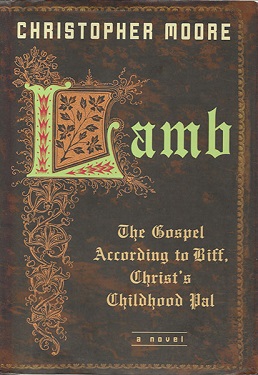Lamb: The Gospel According to Biff, Christ's Childhood Pal facts for kids

First edition
|
|
| Author | Christopher Moore |
|---|---|
| Country | United States |
| Language | English |
| Genre | Humor, mystery, adventure, absurdist fiction, comic fantasy |
| Publisher | William Morrow |
|
Publication date
|
2002 |
| Media type | Print (Hardback & Paperback) |
| Pages | 464 |
| Followed by | Fluke, or, I Know Why the Winged Whale Sings |
Lamb: The Gospel According to Biff, Christ's Childhood Pal is a funny novel written by American author Christopher Moore. It was published in 2002. This book tries to imagine what happened during the "lost years" of Jesus. It tells the story through the eyes of Jesus' best friend from childhood, named "Levi bar Alphaeus," who everyone calls Biff.
The first version of Lamb came out in both hardback and paperback. It included a special note from the author explaining how he got the idea for the story. In 2007, a gift edition was released. This version had a second note from Moore, sharing memories from his research trip to Israel.
Contents
The Story of Lamb
Biff, Jesus' childhood friend, is brought back to life in modern times. His job is to help complete the missing parts of the Bible. An angel named Raziel is supposed to supervise him, but Raziel isn't very good at it. Biff then tells the story of his adventures with Joshua, which is the Hebrew name for Jesus.
Joshua's Journey East
Biff explains that he and Joshua travel East together. They want to find the Three Wise Men who visited Joshua when he was born. These Wise Men include a magician, a Buddhist teacher, and a Hindu yogi. Joshua hopes to learn from them how to become the Messiah.
Over twenty years, Joshua learns a lot and even goes beyond what the Wise Men teach him. He learns to make food multiply from one Wise Man. From another, he learns how to become invisible. Joshua's ability to bring people back to life is how he first met Biff when they were children.
Biff and Joshua's Friendship
Throughout their journey, Biff is always sarcastic, practical, and very loyal to Joshua. Joshua, on the other hand, can be a bit moody and sometimes too idealistic. Their different personalities create many funny situations.
The book humorously explains how some things we know today might have started. For example, it suggests funny origins for judo and cappuccino. It also gives reasons why some Jewish families eat Chinese food on Christmas. And it even explains how rabbits became connected with Easter.
Inspirations for the Book
The author, Christopher Moore, said that the novel The Master and Margarita by Mikhail Bulgakov partly inspired him. That book included parts of the Bible story told from Pontius Pilate's view.
Other important writings that influenced Lamb include:
- The ideas of Lao Tzu
- The Torah
- The Upanishads
- The Bhagavad Gita
- Sun Tzu's The Art of War
- The Tao Te Ching
- The Gospels from the New Testament
The idea that Jesus traveled to Kashmir, India, to study at a Tibetan monastery before his public work was first suggested by Nicolas Notovitch. This idea appeared in his 1894 book The Unknown Life of Jesus Christ, which was later found to be a hoax.
About a Sequel
In 2015, Christopher Moore talked about writing a sequel to Lamb. He said he was determined not to write one. He explained that at every book signing, fans tell him Lamb is their favorite book and ask for another.
However, Moore believes that if he wrote a sequel, readers would likely say it was good, but "not as good as Lamb." He doesn't want to try to beat Lamb and risk disappointing his readers. So, he prefers to leave the story as it is.
See also
 In Spanish: Cordero, el evangelio según el mejor amigo de la infancia de Jesucristo para niños
In Spanish: Cordero, el evangelio según el mejor amigo de la infancia de Jesucristo para niños

